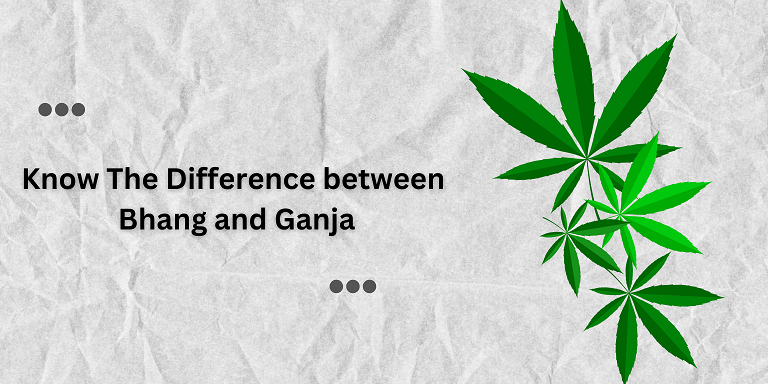Bhang vs. Ganja: Key Differences, Effects, and Health Insights

Bhang and Ganja are two popular intoxicants in the Indian subcontinent, both derived from the same source—the Cannabis plant. However, they differ significantly in their preparation, consumption, and effects. While bhang is deeply rooted in Indian traditions, often consumed during festivals like Holi, ganja is more potent and typically smoked, with its popularity rising among urban youth.
This blog explores the differences between bhang and ganja, their cultural significance, and the effects they have on the mind and body.
What Is Bhang? The Traditional Intoxicant of India
Bhang is a preparation made by grinding and soaking dried leaves and buds of the Cannabis Sativa plant. It is commonly used to make food and drinks, especially during festivals and celebrations in India.
Key Facts About Bhang:
-
Cultural Significance: Consumed during Holi and other festivals, often associated with Lord Shiva.
-
Legal Status: The sale and consumption of bhang made from cannabis leaves are largely tolerated under Indian law.
-
Popular Consumption Methods:
-
Bhang Lassi: A blend of curd, water, or milk infused with ground cannabis leaves.
-
Bhang Goli: A simple preparation of cannabis leaves mixed with water.
-
According to research by Statista, approximately 2% of India’s population consumes bhang, highlighting its widespread acceptance.
What Is Ganja? A Potent Cannabis Preparation
Ganja, also known as marijuana, weed, or pot, is a more potent preparation made from the dried flowers and resin of the hemp plant. Unlike bhang, which is usually ingested, ganja is typically smoked.
Key Facts About Ganja:
-
Potency: Contains higher levels of THC, making it more intoxicating than bhang.
-
Consumption Method: Commonly smoked for its rapid effects, which can be felt within 30 minutes.
-
Legal Status: Possession of ganja is illegal in India, with strict penalties under the Narcotic Drugs and Psychotropic Substances (NDPS) Act.
Major Differences Between Bhang & Ganja
| Aspect | Bhang | Ganja |
|---|---|---|
| Preparation | Leaves of Cannabis Sativa plant | Flowers, resin, and leaves |
| Consumption Method | Ingested in food and drinks | Smoked |
| Potency | Mild | High |
| Legal Status | Tolerated | Strictly illegal |
| Time to Take Effect | 2-3 hours | 30 minutes |
Cultural Significance of Bhang and Ganja
Bhang:
Bhang holds a special place in Indian culture, especially during festivals like Holi. It is consumed as a part of traditional rituals, often mixed into thandai (a milk-based drink with spices and nuts). Bhang consumption is also linked to Lord Shiva, symbolizing spiritual transcendence.
Ganja:
Ganja, on the other hand, has been historically used by Hindu ascetics (sadhus) during meditation to achieve detachment and spiritual enlightenment. In modern times, it is often consumed recreationally, with less focus on its ritualistic roots.
How Bhang and Ganja Produce High: The Role of THC and CBD
Both bhang and ganja derive their psychoactive effects from two primary compounds found in cannabis:
-
THC (Tetrahydrocannabinol): The compound responsible for the "high," affecting mood, memory, and motor functions.
-
CBD (Cannabidiol): Known for its calming and anti-inflammatory properties, often counteracting some of THC’s effects.
These compounds bind to the body’s endocannabinoid receptors, influencing processes like decision-making, motor functions, and emotional regulation.
The Medical Benefits of Cannabis
When consumed in controlled quantities, cannabis can offer several health benefits:
-
Relief from chronic pain (National Academies of Sciences, Engineering, and Medicine).
-
Treatment for mental health issues like depression and social anxiety.
-
Alleviation of nausea and vomiting during chemotherapy.
-
Management of epilepsy symptoms.
The Health Risks of Cannabis
Excessive or prolonged use of cannabis can lead to:
-
Exacerbation of mental illnesses, such as bipolar disorder.
-
Increased risk of depression and suicidal thoughts.
-
Potential link to slow-growing seminoma subtype of testicular cancer.
-
Respiratory diseases from smoking.
Can Cannabis Help Fight Addiction?
If you’re struggling with ganja addiction, switching to medical cannabis products like herbal cigarettes can help. These alternatives are designed to reduce dependency while offering controlled benefits. Medically approved and licensed by the Ministry of Ayush, they are a safer option for quitting.
Wrapping Up
Cannabis, in the forms of bhang and ganja, plays a significant role in Indian culture and health practices. While it has notable benefits, it’s essential to consume it responsibly to avoid health risks and legal issues. If you’re seeking a safer and healthier way to enjoy cannabis, explore hemp-based products like herbal cigarettes for a controlled and therapeutic experience.
Take charge of your well-being today and embrace a balanced approach to cannabis consumption.

Comments on this post (4)
Launch into the stunning universe of EVE Online. Find your fleet today. Trade alongside hundreds of thousands of players worldwide. Join now
— RobertPaw
Dive into the vast sandbox of EVE Online. Become a legend today. Create alongside millions of players worldwide. Join now
— MichaelGow
I was diagnosed with COPD four years ago. For over two years, I relied on inhalers and several other medications, but unfortunately, the symptoms kept getting worse. My breathing became more laboured, I experienced frequent coughing fits, and my energy levels started to decline quickly. Last year, out of desperation and hope, I decided to try an herbal treatment program from NaturePath Herbal Clinic. Honestly, I was skeptical at first, but within a few months of starting the treatment, I began to notice real changes. My breathing became easier, the coughing subsided, and, incredibly, my energy returned. It’s been a life-changing experience. I feel more like myself again better than I’ve felt in years. If you or a loved one is struggling with COPD, I truly recommend looking into their natural approach. You can visit their website at www.naturepathherbalclinic.com
— Belinda
As I have been chemistry student so interested in deep study about Hemp (CBD & THC)
— DR.R.K.Tripathi